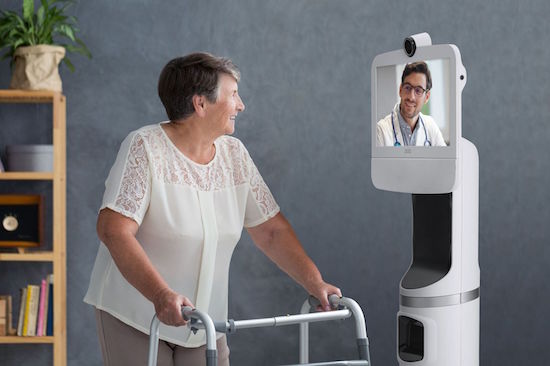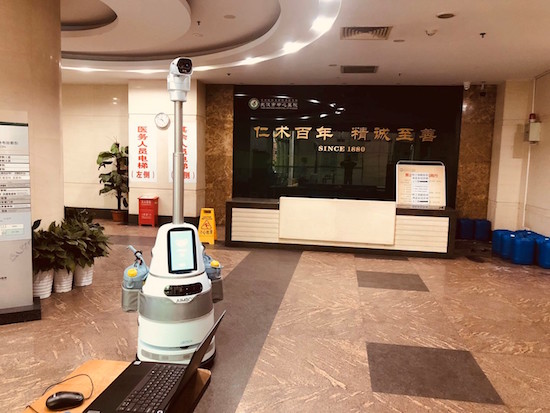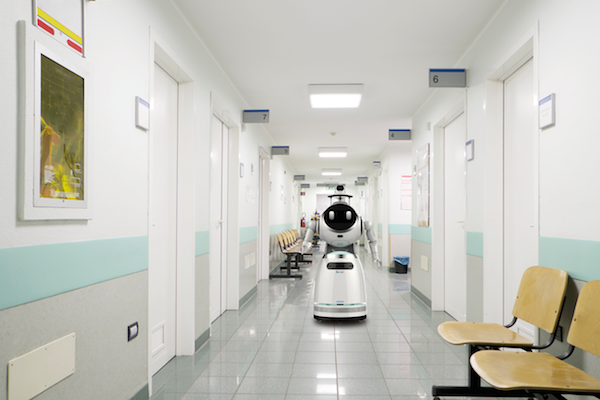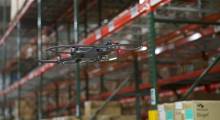As countries plod through the toll of a worldwide pandemic, technology continues to solve problems and hurdle over obstacles. Health care facilities are one such sector. There, health care professionals—the ones who need to get close—are suddenly put in danger as the communicable coronavirus poses a dangerous health risk to them and others who perform tasks within the facility.
The robotics revolution is proving to be an uncanny solution to alleviate the human presence in a setting that prides itself on care and connection. The very presence of the robot serves the purpose of companionship ordinarily provided by a human being.
Tom Koulopoulos is chairman and founder of Delphi Group, a Boston-based think-tank that advises Fortune 500 companies and governments on future trends. He is the author of “Reimagining Health Care” (Post Hill Press, May 2020).
“The challenge in talking about the use of robots in health care is not so much a technical one as it is a very human challenge of perception, emotions and the cornerstone of all effective health care, the physician-patient relationship,” comments Koulopoulos.
Dean Slawson is the VP of advanced technologies at PointClickCare in Mississauga, Ontario, Canada. “As with any technology, the application of robots needs to be selected or designed to be suitable for the task at hand,” says Slawson. “There are many functions in health care that humans perform that offer interesting potential for the use of robotics. For example, one can imagine cases where robots would reduce the contact exposure to infection for health care workers, such as passing medications.”
Slawson notes that robots are solid and hard surfaces, and still need to be disinfected.
“Obviously, that would be a huge benefit amidst this pandemic and reducing med pass costs could be a major cost and labor saver even without a pandemic,” he says. “However, such a robot would still need to be disinfected as it goes from patient to patient, would need to have been designed to operate safely in the presence of humans in an uncontrolled space, be able to ensure medication compliance, such as coaxing a senior resident who is hiding the medication under their tongue, or deal with, for example, an incident of choking while swallowing.”
Increasingly Feasible
Robots aren’t strangers to health care. But they are showing their worth as intelligent machines that can help in the many hospital settings overwhelmed by COVID-19 infections.
Robert Gao, Ph.D., is the Cady Staley professor and department chair, Mechanical and Aerospace Engineering, at Case Western Reserve University.
“I think this is becoming increasingly feasible,” says Gao. “The key is to improve the level of ‘intelligence’ needed for accurate and foolproof ‘situational awareness,’ i.e., accurately and reliably recognizing the environment and people’s need or intention to guide the robot’s action.”
Gao says intelligence development can be done in stages: first semi-autonomous, where the robot performs preprogramed jobs under the supervision of humans (nurses, nutritionists, caretakers, doctors), and then gradually moving into a more autonomous mode.
“What we have shown is that once good prediction of human motion is enabled, a robot can be an effective player in a collaborative scheme,” notes Gao. “We are not there yet, in terms of achieving full autonomy; but what we have seen that machine learning/AI can do is definitely promising and encouraging. In that sense, translating the technology to health care/assisted living facilities is feasible.”

Ava Robotics in Cambridge, MA, has developed intelligent machines that serve a different purpose. They are telepresence robots that enable remote visitations, from either physicians or a patient’s family and friends. They also assist in uniting larger health care teams, allowing for easier collaboration, and provide other remote staff the ability to get important tasks done. These robots help patients more quickly, without requiring in-person physician attendance.
“Whether in more urgent or restrictive times, or business-as-usual situations, the ability to be anywhere at any time creates efficiencies and promotes higher satisfaction for physicians, nurses, operational managers, patients, visitors and any other party involved in providing or receiving health care service,” says Molly Gardner, director of marketing for Ava Robotics. “Telepresence robots work to extend health care providers’ reach and improve the overall continuum of patient care.”
The U.S. saw a surge of infections after growing numbers in China, particularly in the city of Wuhan, the capital of Central China’s Hubei province. Robots were used in Wuhan during the outbreak.
Olivia Chi is a spokesperson for UBTECH Robotics based in Shenzhen, China. UBTECH robots used artificial intelligence to assist in the COVID-19 crisis in and out of hospitals. In fact, one of UBTECH’s robots, the AIMBOT robot, was used at Wuhan Central Hospital to perform tasks so human beings didn’t have to, reducing their risk of infection.
“This self-moving AIMBOT robot has been working alongside medical staff since March at Wuhan Central Hospital, where frontline health care workers were among the most hit by the COVID-19 virus,” explains Chi. “One AIMBOT robot can help save labor force of four workers and reduce the workload of the nurse on duty by 80 percent.”
She cites a nurse at the hospital who noted that the accuracy of temperature monitoring by AIMBOT was much higher than handheld thermometers. Its identification and warning of people running a high fever was on time, which reduced the risk of missing potential infected people and protected the safety of medics.
Robots or Vehicle?
When considering robots in the hospital, imagine a machine that is more humanoid in functionality. But the same technology may also drive vehicles that perform analogous functions to an individual robot but serve as internal transportation in the health care facilities. These buildings can be long, wide and spacious, stretching what seems like miles of hallways, floors, buildings and facilities, often nestled on a single campus we now call a hospital.

Haewon Kim-LaBroad is the director of clinical planning at Hoefer Wysocki, an interdisciplinary architecture, planning and interior design firm in Dallas. Kim-LaBroad supports the use of automated guided vehicles (AGV) in a health care facility.
“Against the backdrop of COVID-19, and infectious disease in general, there is unique value in using the automated guided vehicles rather than a human staff member simply because contagion via human contact can be minimized to essential health care functions,” says Kim-LaBroad.
“However, even outside of COVID-19, in what we would typically refer to as ‘normal,’ there is a lot of value in the prioritizing of the more productive labor related to health care that takes place in a hospital. Rather than humans performing tasks such as delivering items up and down the hospital corridors, they can utilize the AGV system. Secondly, it also helps mitigate some of the human error component that naturally occurs in all workplaces.”
According to Kim-LaBroad, these systems have come a long way since their introduction and are sophisticated in programming.
“More than 10 years ago, when working with a large academic medical center here in the Dallas-Fort Worth metro area, we surveyed different uses for AGV systems. I recall them being so ‘smart’ that when they were about to run out of power, they returned to their home base to recharge,” Kim-LaBroad says. “Delivery functions are also very inherent; the robot knows exactly where it needs to go, and it can do so without distraction or interruption.”
The AGV technology migrated to health care from manufacturing.
“The use of AGVs began in the manufacturing sector where they were used to move small components across expansive factory floors,” says Travis Leissner, vice president and director of strategy at Hoefer Wysocki. “They moved on to the health care sector later. I first saw their application at large medical centers and on campuses with multiple buildings where they transported items from building to building. Now, sensors and cameras allow them to detect when they need to stop for a car, and they can be programmed to stay on a certain path, such as in a crosswalk. This removes the element of risk involved with a human, who can be injured performing the same task.”
Displacing the Human Connection? Only Where and When Needed
“When most people think of robots, they tend to anthropomorphize as robotic nurses or health aides that can attend to patients in cases where staffing is too low, risks to the clinician are too high, or the conditions are such that quality care needs to be provided remotely,” says Koulopoulos. “The danger in all these cases is that we may create a highly scalable health care system that lacks the human connection that is so vital to it. For example, patients who see PCPs (personal care physicians) spend 33 percent less on health care than those who only see specialists, and the same patients have a 19 percent lower overall likelihood of premature death.”
Perhaps this is true. However, these are not ordinary times. Robotics, anecdotally, have come to the rescue to alleviate the human connection for just a while. They are helping the nation and our world beat the virus. It may be a preview of things to come where health care robotics is an asset to help manage patients, and occasionally, pandemics.
Jim Romeo is a freelance writer based in Chesapeake, VA. Send e-mail about this article to [email protected].
About the Author
Follow Robotics 24/7 on Linkedin
Article topics
Email Sign Up
















